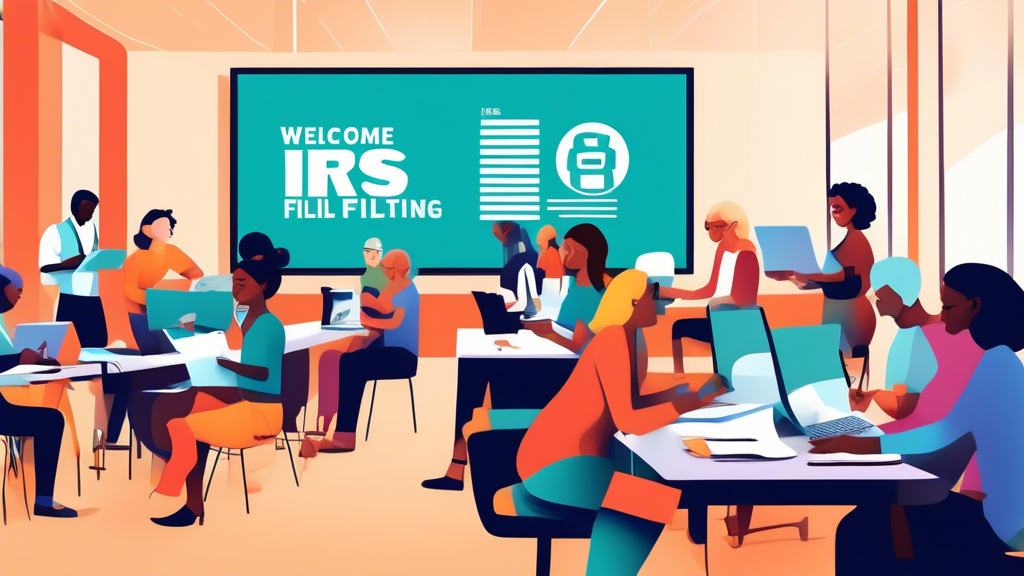Guide to Using the IRS Free Tax Filing Service
Welcome to your comprehensive guide on the IRS free tax filing service, a convenient and cost-effective solution tailored to meet the needs of eligible taxpayers. Each year, millions of Americans take advantage of this lesser-known gem offered by the Internal Revenue Service, designed to simplify the tax filing process without adding any financial strain. Whether you’re filing as a first-time taxpayer or you’re a seasoned filer looking for an easier way to manage your annual tax obligations, understanding the IRS free tax filing service could be pivotal in efficiently handling your taxes.
The IRS free tax filing service offers a dual benefit of easy accessibility and cost savings, making it an ideal choice for eligible individuals seeking a straightforward tax filing experience. Recent statistics reveal that a significant percentage of taxpayers who are eligible for this free service benefit from its user-friendly interface and helpful features, reporting high satisfaction rates. In this article, we’ll explore who qualifies for free filing, how you can determine your eligibility, and provide a detailed, step-by-step guide on how to file your taxes using this service.
Embarking on your tax filing journey with the IRS free tax filing system can transform what is often seen as a daunting task into a manageable and fulfilling activity. Let’s dive into discovering how this valuable IRS program can help you file your taxes efficiently and save money in the process.
“`html
“`
Guide to Using the IRS Free Tax Filing Service
Introduction to IRS Free Tax Filing
Welcome to your streamlined guide to navigating the IRS free tax filing service, a crucial tool designed to ease the tax filing process for millions of eligible Americans. Whether you are a first-time filer or someone looking to switch to a more cost-effective method, understanding and utilizing this service can significantly simplify your financial responsibilities.
What is IRS Free Tax Filing?
The IRS offers a free tax filing service that helps eligible taxpayers prepare and file their federal income tax online at no cost. This initiative, part of the Free File Alliance, is a partnership between the IRS and several tax preparation and filing software companies. It’s aimed at supporting low to moderate-income taxpayers who might otherwise find the cost of filing a tax return prohibitive. In the broader sense, this service is an empowering tool, democratizing tax services for all who qualify.
Who is it designed for?
This program primarily benefits individuals or households with an adjusted gross income (AGI) below a certain threshold, which typically shifts slightly each year due to inflation adjustments. The service is tailored to be user-friendly and accessible, ensuring that even those with little to no experience in tax filing can navigate the process smoothly.
Primary Benefits
The primary benefits of the IRS free tax filing service include cost savings, ease of use, and direct access to various tax preparation software that would otherwise be costly. This service includes error-checking features and step-by-step guidance to help avoid common mistakes. It also provides the options for direct deposit of refunds, which can expedite the refund process significantly.
Accessibility and Cost-Effectiveness
For eligible taxpayers, the IRS free tax filing service not only stands out as an accessible option but also as a cost-effective one. Accessibility is a primary focus, ensuring that services are available online 24/7 during the filing season, providing convenience to users regardless of their schedule or time constraints. Touted for its cost-effectiveness, users are spared the usual fees associated with professional tax services or sophisticated software, making it an appealing choice for eligible filers looking to maximize their refund without incurring additional costs.
Statistics and User Satisfaction
Using the IRS free tax filing service, millions of taxpayers securely file their taxes each year. According to IRS reports, the program has seen consistent growth in user uptake rate, with satisfaction scores reflecting appreciation for its ease of use and reliability. For instance, in recent filing seasons, over 70% of users rated their experience as either good or excellent, highlighting the effective adoption and impact of this program among its target demographic.
In conclusion, IRS free tax filing serves as an invaluable resource for eligible taxpayers seeking a straightforward and economical way to manage their tax obligations. By leveraging this service, users can ensure their taxes are filed correctly and efficiently, potentially leading to quicker refunds and fewer errors—benefits that underscore the importance of this government-provided service.
As we move forward in this guide, we’ll delve into specifics regarding eligibility, giving you deeper insights into whether you can take advantage of IRS free tax filing, and what steps you need to take to do so effectively.
Stay tuned as we transition to understanding the eligibility criteria necessary for taking advantage of this free service. Ensuring you meet these criteria is your next step toward a smoother and more cost-effective tax filing experience.
—
By integrating user-focused benefits, accessibility, and clear explanations, this segment anchors the reader’s understanding of IRS free tax filing, setting a solid foundation for deeper exploration in subsequent sections.
Eligibility Criteria for Using IRS Free Tax Filing
When it comes to tax time, navigating the maze of forms, regulations, and deadlines can be daunting. Fortunately, the Internal Revenue Service (IRS) offers a beacon of relief with its IRS Free Tax Filing service. This program is specially designed to aid eligible taxpayers in handling their taxes without a financial burden. However, understanding whether you qualify for this beneficial service is vital. In this segment, we will dive deep into the eligibility criteria for the IRS free tax filing service, unpacking various factors such as income thresholds, filing status, age, and other relevant elements.
Income Thresholds
The most pivotal factor determining eligibility for the IRS Free Tax Filing service is your income. For the current tax year, the service is available to anyone who has an Adjusted Gross Income (AGI) of $72,000 or less. This criterion caters to many taxpayers, aiming to cover those in the low to moderate-income bracket. It’s essential to check updates annually as this threshold may adjust to reflect changes in the economy and cost of living.
Filing Status and Age
Your filing status also plays a critical role in determining your eligibility for free tax filing services. Whether you are filing singly, as married filing jointly, head of household, or any other status, you can use the IRS free service provided you fall under the aforementioned income cap. Age, however, is generally not a restriction for the service, making young adults filing for the first time equally eligible as older adults.
Special Considerations for Certain Groups
In addition to general eligibility criteria, the IRS acknowledges various groups may need specific considerations. For instance, active military personnel with an income of $72,000 or less can receive assistance through the IRS Free File Program. The platform offers access to certain forms needed for military filings, which can be filled out and filed at no cost.
Another group to note includes senior citizens who may often feel overwhelmed by tax filing. For individuals over the age of 60, the IRS collaborates with organizations to provide free tax help, not necessarily restricted by the income levels set for the general public under the Free Tax Filing service.
Navigating Eligibility Checks
The first step in utilizing the IRS free tax filing is confirming your eligibility through the IRS website. An easy-to-use tool called the IRS Free File Online Lookup Tool assists taxpayers in determining which filing offers they qualify for. By inputting simple information like age, income, and state of residence, the system provides a list of Free File software options that match your situation.
Documents to Gather
Before you begin the process of filing your taxes through the IRS Free File service, assembling all necessary documents is crucial. This includes your Social Security number, W-2 forms from employers, 1099 forms if you are self-employed, any documents pertaining to other sources of income, and last year’s tax return. Having these documents at hand will streamline the process, making your tax filing experience smooth and stress-free.
Conclusion
Understanding and meeting the eligibility criteria for the IRS Free Tax Filing service can pave the way to a more manageable tax season. By ensuring you fall within the income limits, checking the appropriate filing status, and gathering necessary documents, you can take full advantage of this free service. Remember, the IRS website is a comprehensive resource equipped with tools and information to guide taxpayers through the eligibility checks and subsequent filing process, ensuring that everyone who qualifies can file their taxes efficiently and cost-effectively. With IRS Free Tax Filing, navigating tax season has never been simpler.
Guide to Using the IRS Free Tax Filing Service
Step-by-Step Guide to Filing with the IRS Free Service
Navigating the tax season can be a daunting task for many. However, with the IRS free tax filing system, eligible taxpayers can simplify the process and ensure they meet their legal obligations without the added stress of incurring filing fees. This section provides a detailed walkthrough of how to use the IRS free tax filing system efficiently.
Step 1: Creating an Account
To begin using the IRS free tax filing service, you first need to create an account. Visit the official IRS website and locate the section dedicated to free filing. Here, you will find various authorized IRS e-file providers. Select one that best suits your needs and follow their process to create an account. Ensure you have your social security number, a valid email address, and your filing status at hand. This information will be crucial for setting up your account.
Step 2: Entering Your Tax Information
Once your account is set up, the next step involves entering your tax information. You can either manually input your details or, if available, import last year’s tax returns to expedite the process. It’s essential to have all relevant documents ready, such as your W-2s, 1099s, and any deductions or credits you plan to claim. Accuracy is key to avoiding errors that could delay your return or result in an audit.
Step 3: Reviewing Your Tax Information
After entering your information, take the time to review everything carefully. Check for any discrepancies or missed entries. Errors are easier to correct now than after you have submitted your tax return. Most IRS free tax filing platforms offer a review tool that scans your return for common errors and ensures you have taken advantage of all eligible tax breaks.
Step 4: Submitting Your Tax Return
Once you’re satisfied with the information entered, proceed to submit your tax return electronically through the IRS free tax filing service. You will receive a confirmation or acknowledgment from the IRS once your return has been accepted. It’s important to save or print this confirmation for your records.
Troubleshooting Common Issues
Even with a straightforward system like the IRS free tax filing service, you may encounter issues. Common problems include incorrect entry of social security numbers, discrepancies in reported income, or issues with your e-file provider. If you encounter any problems, refer to the IRS’s online resources or call their helpline. Ensure you have your tax return details and confirmation number ready to expedite the process.
What to Expect After Submission
After submitting your return, you can track its status using the ‘Where’s My Refund?’ tool available on the IRS website. Typically, e-filed tax returns with direct deposit information can expect a refund within 21 days if there are no issues with the return. Additionally, keep an eye out for any notifications from the IRS in case further information is needed to process your return.
Conclusion
Using the IRS free tax filing system can significantly ease the burden of tax season. By following these steps, you ensure that your tax filing process is not only cost-free but also straightforward and efficient. Remember, preparation and attention to detail are vital in ensuring that your tax submission is successful.
For more guidance or assistance, never hesitate to consult with a tax professional or reach out to the IRS directly. Happy filing!
### Conclusion
Navigating the complexities of tax filing can often seem daunting. However, the IRS free tax filing service streamlines this annual task, making it accessible and manageable for eligible taxpayers. With the guidance provided about who qualifies for this service, coupled with the outlined steps on how to file, taxpayers can embrace a smoother, cost-free method of filing their returns.
As discussed earlier, this service not only aids in maintaining financial health by minimizing expenditure during tax season but also ensures compliance with tax laws through a user-friendly digital interface. The benefits of utilizing the IRS free tax filing system extend beyond its no-cost nature, providing peace of model ensuring accuracy and speeding up the refund process.
If you fall under the eligibility criteria, take advantage of this beneficial resource. Remember that the IRS is available to assist if you encounter any hurdles along the way. Tax season need not be a time of stress or expense. By leveraging the resources available through the free tax filing system, you can not only fulfill your civic duty but also do so in a way that is efficient and economical.
As you prepare for your tax submission this year, consider the IRS free tax filing service as your go-to option for a straightforward and fuss-free tax filing experience. Whether you’re a seasoned filer or new to the process, this service is designed to help you every step of the way. After all, smarter filing means smarter finances, and with the IRS free tax filing service, you’re well on your way to achieving just that.





